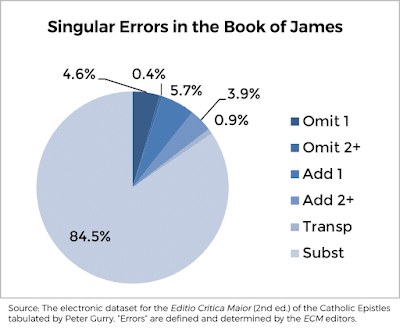I recently finished working through all the singular readings in James according to the Editio Critica Maior (ECM). There are 1,245 of them according to my data. I picked James because it has the most manuscripts of all the books in the ECM of the Catholic Epistles.
One result from my data is the various types of changes that occur among the singular errors. Here “error” (Fehler) is any reading that didn’t make either logical or grammatical sense to the editors (p. 27*) and “singular” is defined relative to the Greek manuscripts in the ECM. There are 493 such singular errors (39.6% of all singulars).
Using the basic categories from Royse, the singular errors in James divide as follows:
As you can see, the vast majority are substitutions (84.5%). Unexpectedly, additions outnumber omissions almost 2:1 (9.6% vs. 5.0%). This is not true of singular readings as a whole in James where, as in Royse’s study, omissions outnumber additions. You could make an argument that singular errors provide us with greater “moral certainty” (to use Hort’s phrase) about their being scribally created than non-error singulars since nonsense is less likely to be copied than sense. But I find that there is a certain trade off in studying scribal change between the guarantee of purity in the data (“moral certainty”) and the volume of the data. At some point, more data that’s less pure is actually better (i.e., more representative) than less data that’s more pure. But more on that another time.
To give a flavor of some of these errors, here are the first two verses of James.
I should also note that I am counting cases of these changes such that if two words are replaced, this counts as one substitution. Likewise, a five word addition would count as one case of a “2+ addition.”
An interesting study would be to consider the non-singular errors alongside the singular errors to see if there are any patterns that might help explain why some were made more than once (assuming they are non-genetic). If anyone is interested, you can download the spreadsheet with all 493 singular errors.
One result from my data is the various types of changes that occur among the singular errors. Here “error” (Fehler) is any reading that didn’t make either logical or grammatical sense to the editors (p. 27*) and “singular” is defined relative to the Greek manuscripts in the ECM. There are 493 such singular errors (39.6% of all singulars).
Using the basic categories from Royse, the singular errors in James divide as follows:
As you can see, the vast majority are substitutions (84.5%). Unexpectedly, additions outnumber omissions almost 2:1 (9.6% vs. 5.0%). This is not true of singular readings as a whole in James where, as in Royse’s study, omissions outnumber additions. You could make an argument that singular errors provide us with greater “moral certainty” (to use Hort’s phrase) about their being scribally created than non-error singulars since nonsense is less likely to be copied than sense. But I find that there is a certain trade off in studying scribal change between the guarantee of purity in the data (“moral certainty”) and the volume of the data. At some point, more data that’s less pure is actually better (i.e., more representative) than less data that’s more pure. But more on that another time.
To give a flavor of some of these errors, here are the first two verses of James.
| Error] correct reading | Error # | Address |
|---|---|---|
| δου] δουλος | f | 1.1/14 |
| τη διαασπορα] τη διασπορα | f1 | 1.1/26–28 |
| φερη] χαιρειν | f | 1.1/30 |
| χαριαν] χαραν | f | 1.2/4 |
| πειρασμος] πειρασμοις | f | 1.2/14 |
| περιπεση] περιπεσητε | f1 | 1.2/16 |
| περιπεσητω] περιπεσητε | f2 | 1.2/16 |
| ποικιλλοι] ποικιλοις | f2 | 1.2/18 |
I should also note that I am counting cases of these changes such that if two words are replaced, this counts as one substitution. Likewise, a five word addition would count as one case of a “2+ addition.”
An interesting study would be to consider the non-singular errors alongside the singular errors to see if there are any patterns that might help explain why some were made more than once (assuming they are non-genetic). If anyone is interested, you can download the spreadsheet with all 493 singular errors.
